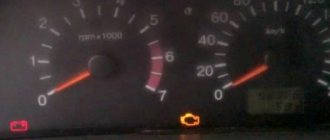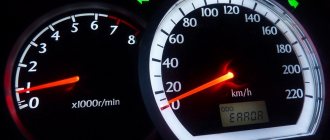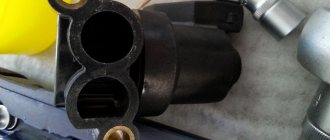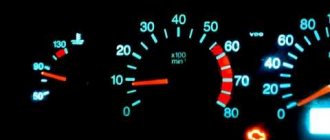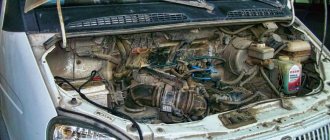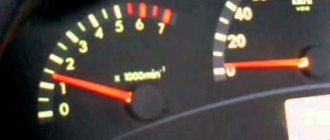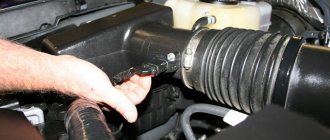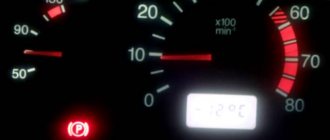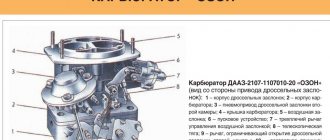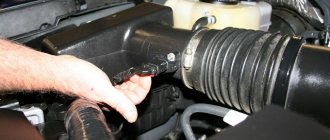Problems with engine idle speed, such as a drop or, conversely, too high and not falling idle speed, poor idle in the form of a constantly stalling engine, unstable (jumping) idle - all these are symptoms that must be investigated and diagnosed and, of course, renovated. The following symptoms and associated problems should act as a guide to help you troubleshoot engine idle issues.
Symptom: An unheated (cold) engine is unstable at idle.
When the engine is cold and you take your foot off the gas pedal, the engine runs very rough and may even stall. When starting the engine at high speed, it seems to run fine.
Possible reasons:
- If you have a carbureted engine (Hi Grandpa!), you may have a faulty accelerator pump or engine power circuit. Replace the accelerator pump or replace the carburetor assembly.
- You may have a vacuum leak. Check and replace vacuum lines as needed.
- You may have various types of ignition problems. Check and replace the distributor cap, rotor, ignition wire, or spark plug depending on what exactly the problem is.
- The ignition timing may be set incorrectly. Adjust the ignition timing.
- The vehicle may have an error in the computer engine management system. Check the control system (ECU) using a scan tool. This is no longer an independent work, although nothing prevents you from doing it yourself.
- The exhaust gas recirculation valve may be faulty. Replace the recirculation valve.
- The engine may have mechanical problems. Check the compression to determine the condition and possibly the approaching engine life limit.
- Fuel injectors may be dirty. Clean or replace fuel injectors.
Absolutely all of these possible problems listed can occur in the case of a similar symptom: when the engine does not operate unstably at idle while it is already warmed up. When the engine is warm and when you take your foot off the gas pedal, the engine runs very rough and may even stall. But when the engine is in gear and at high speeds, it appears to be running fine.
Symptom: Idle speed too high
After the engine has been running long enough to warm up, the idle speed does not drop to its usual normal value. You notice this when you get into your warm car and notice that it is still too loud and the revs on the tachometer have not dropped, you may even have to press too hard on the brake pedal to keep the car from moving in case, if you have an automatic transmission.
Possible reasons:
- If you have a carbureted engine, you may have a faulty accelerator pump or power circuit. Replace the accelerator pump or the entire carburetor assembly.
- The engine may overheat. In this case, check and repair the cooling system.
- The fuel pressure regulator may be operating at too low a pressure. Check the fuel pressure using a pressure gauge. Replace the fuel pressure regulator if it is found to be faulty. (Unfortunately, this is not a DIY project.)
- The ignition timing may be set incorrectly. Adjust the ignition timing.
- You may have an error in the engine management computer system. Check the engine management system using a scan tool.
- Your car's alternator may not be working properly. In this case, most often only replacing the generator helps.
Symptom: Car stalls at idle
You are driving your car, and everything is just fine... Until at one point you don’t let go of the gas pedal. The engine begins to vibrate strongly due to low speeds and may stall completely. Not a very pleasant situation, because in this case you lose power steering when the engine stalls at idle.
Possible reasons:
- There may be a serious leak in your vacuum system. Check and replace vacuum lines as needed.
- There may be an error in the engine management computer system. Check the engine management system using a scan tool. You must either ask for the parameters or reconfigure them correctly.
Stalls at idle, why?
Such a problem as: the engine stalling at idle speed can be heard quite often. And even if after some period of time the engine does start, the cause of the malfunction will have to be looked for one way or another. And the sooner the better, because there may be several of them.
Reasons why the engine stalls
In all cases when the engine is unable to maintain idle speed, the malfunction is associated with contamination or failure of any part. The most basic elements to pay attention to:
- Clogged or broken idle air regulator.
IAC on VAZ-2112
- Carbon deposits or contamination of the throttle valve and injector channels require cleaning and diagnostics.
Cleaning the throttle valve from dirt
- The presence of significant deposits in the fuel supply system and fuel pump, as well as the grid.
- Failure of the mass air flow sensor.
- The engine crankcase ventilation system is dirty.
Location of the throttle valve on a VAZ-2112 - photo of an editorial car
We recommend: Changing the oil in the Daewoo Nexia gearbox
Gasoline engine does not idle
Let's start with the fact that this malfunction indicates two possible causes: failure of individual mechanisms, components or sensors, as well as severe contamination of certain elements. In both the first and second cases, it is necessary to carry out a diagnosis. The engine on injection and carburetor cars can most often stall at idle in the following cases:
- the idle air regulator (IAC) has failed;
- the throttle valve is dirty or malfunctioning;
- the carburetor channels are clogged or the fuel jet XX is dirty;
- the performance of injection nozzles is reduced or impaired;
- the mesh of the electric/mechanical fuel pump is clogged, malfunctions of this unit have occurred;
- there was a decrease in the throughput of the fuel filter;
- the air filter is dirty, air leaks at the inlet;
- failure of the mass air flow sensor, throttle position sensor, etc.;
- clogging of the engine crankcase ventilation system;
If the car immediately stalls or the speed fluctuates noticeably after the starter is turned off, then you should pay attention to the throttle assembly. It is possible that the valve may become clogged or the mechanism may become jammed. This malfunction, especially severe contamination, occurs as a result of prolonged driving on low-quality fuel, as well as untimely replacement of the air filter.
In this case, the throttle valve needs to be cleaned. To clean the throttle, use a regular “carbicleaner” (a product for cleaning carburetors), and you also need to blow out the valve using compressed air from the compressor. If these steps do not help, then you will need to evaluate the condition of the oil trap. This element is an integral part of the engine crankcase ventilation system. A dirty oil trap causes crankcase gases to “choke” the engine, idle speed floats and the internal combustion engine stalls.
Now let's look at a situation where the car starts normally, but then starts to stall (constantly or with a certain frequency). A similar situation often occurs on fuel-injected cars that have an electronic engine control system (ECM).
It is advisable for owners of cars that have been in use for a long time to have these sensors in stock, as well as a multimeter for self-diagnosis. This is especially necessary if the car is often used for long trips along the highway. Note that most of these sensors have an acceptable cost.
Now a few words about the carburetor. The engine often stalls on such engines precisely because of contamination of the jets and prolonged lack of proper carburetor adjustment. The fact is that even small particles of debris in the fuel can disrupt the operation of carburetor injection. Dirt can be contained either in low-grade gasoline or enter the system from the gas tank, in which deposits gradually accumulate.
This product is a solvent-cleaner in an aerosol can. As for the mechanical fuel pump of carburetor engines, this type of pump has a filter mesh. This element can also become clogged, reducing pump performance. The membrane of a mechanical fuel pump can also fail. In parallel with wear, membrane particles clog the channels in the carburetor.
With an injection system on an injector, the situation is more complicated. If replacing the ECM sensors does not help, then you should start checking the intake manifold for excess air leaking into the intake, and also eliminate air in the fuel system. Then you need to move on to checking the injection nozzles, measure the pressure in the fuel rail, inspect the vacuum hoses, etc. The vacuum brake booster will require special attention. We also add that regardless of the type of injection (engines with an injector or carburetor), it is necessary to check the ignition, spark plugs, high-voltage wires, distributor coil and other elements of the system.
Electrical problems
Often the reason that the engine refuses to idle is an incorrectly adjusted ignition angle. True, problems in this case are observed in all ranges of engine operation. All that is required to fix such problems is to set the ignition correctly and that’s it.
Spark plugs that are regularly filled with gasoline, or that have simply expired, can also cause the engine to stall at idle. In addition, you should check the ignition distributor, wiring and battery condition. Especially if the car is running rough, the engine is running rough, with jerks and dips.
Well, the starter will tell you in detail about the condition of the battery, especially on a cold engine. Most electrical problems can be diagnosed and fixed easily and without major investment.
Trouble-shooting
Often there is no fundamental difference which engine is installed in a vehicle - the reasons that the engine stalls will be the same. In carburetor-type engines, a common reason for the engine stopping at idle may be an unadjusted drive, a dirty needle valve, or other problems. To eliminate such malfunctions and improve engine performance, change the fuel filter regularly. If the solenoid valve fails, the speed twitches or drops completely.
When the characteristic clicking sound is not heard when connecting, it is better to replace the valve. In diesel engines, the main role is played by the high pressure fuel pump. If this unit fails, the quality of the fuel, the condition of the electrical wiring, glow plugs and other parts are checked, and the fuel filter is changed. In injection engines, the air filter is first cleaned; it is possible that it will have to be replaced. If vibration is felt at idle, it is recommended to replace the gasket. Also, to eliminate the causes of engine shutdown, the injectors on the engine or on a special device are washed.
Problems with classic and front-wheel drive Lada cars
On such cars, the engine often stalls at idle. If the engine is carburetor, then this is usually the problem. It may be clogged, or the idle jet, which is responsible for the normal operation of the engine at idle, is clogged.
You need to pull out the jet and blow it out, then rinse it with solvent. If this does not help, then you can check the solenoid valve.
To control it, you need to turn on the ignition and disconnect the wire from it. Then connect again. A click should be heard. If it is not there, then you need to measure the voltage on this wire. If the control lamp is on, the valve must be replaced. If it is not possible to purchase a valve, then you can still go a long way if you use a simple method. The valve needle just needs to be broken off. At the same time, fuel consumption will increase slightly, but you will get to your destination.
Injector Lada cars have similar faults: sensor failure. Occasionally, an electronic unit breaks down, which can be found at a repair shop.
Problems with carburetor engines
The idle system in the carburetor is the most sensitive to contamination. Therefore, if a carburetor engine stalls at idle, it is worth blowing out the jets and channels of the idle system, and on cars with electronic forced idle control, also check the operation of the economizer solenoid valve. On Solex carburetors (VAZ 2108-2109), the idle fuel nozzle is mounted on the solenoid valve rod, and if there is no voltage on the valve, it is closed. To make sure that the valve is at fault, on these carburetors it is enough to unscrew it slightly to remove the pressure of the jet against the body and allow fuel to flow past the blocked jet. Has the idle speed stabilized? This means that either the EPHH unit does not supply voltage to the valve (which is checked with a light bulb or a tester), or the valve itself is inoperative.
There are not many reasons why a valve control unit may not supply voltage to it. In addition to the malfunction of the unit itself, this is a loss of power at pin 4, a broken connection with the ignition coil (the EPHH unit stops “seeing” engine speed), and the absence of “ground” at the carburetor end (pin 5) when the gas pedal is released.
Note that a common problem with carburetors is the rigid connection between the composition of the air-fuel mixture from the vacuum and the fuel level in the float chamber. If any of these parameters change, the composition of the mixture will also “float away”. It will go beyond the limits of normal ignition - if the car does not idle until it warms up, then the mixture is over-lean, but if the car stalls when hot, then over-richness is already occurring.
A change in vacuum at idle is a consequence of air leaks through the vacuum lines (for a VAZ, this is often a vacuum brake booster or a vacuum distributor corrector) or a violation of the tightness of the joint between the carburetor and the manifold. Here, Solexes have a long-known disease with warping of the mating plane of the body; Ozones show themselves better in this regard.
The ignition on carburetor cars in the vast majority of cases is distributor-type, with the exception of two-cylinder engines, where it is enough to use a two-terminal coil without spark distribution. If the motor stalls and does not start, then the problem is hidden until the spark is emitted - look at the breaker contacts, the central high-voltage wire, the carbon contact connecting the cover and the slider.
We recommend: Knocking in the front suspension - causes of knocking and how to eliminate them
Problems with spark plugs are common to both carburetor and injection engines. This includes natural wear, which under normal conditions proceeds evenly; sooner or later all the spark plugs in the set will begin to work intermittently, and carbon deposits due to low-quality fuel or a violation of the mixture composition (over-enrichment, carbon black carbon deposits damage the spark plugs). Iron-containing additives (the notorious ferrocene) can “kill” spark plugs in one unsuccessful refill. So you should immediately pay attention to the candles, especially if access to them is not difficult.
Trouble-shooting
- If the reason why the car stalls at idle is low-quality fuel, then regardless of whether it is an injector or a carburetor, it is almost impossible to establish this fact. In such situations, experienced drivers simply drain the fuel. If after completely draining the fuel the problem does not disappear, then the reason is different.
- As for spark plugs, there is a certain scheme, following which you can achieve the desired result. It should be understood that there is one small difference in the spark plugs themselves, intended for a carburetor power plant and an injection one. This difference lies in the size of the gap between the contact of the spark plug and the electrode - for carburetor spark plugs it is larger, and for injection spark plugs it is smaller. But in practice, injection spark plugs are also suitable for a carburetor, and depending on the correct settings, the spark plugs can either work well or not work at all. The functionality of the spark plug is checked simply: with the engine running, at high speeds, you need to pull out the wire leading to the spark plug one by one. If the engine slows down, it means the spark plug is not working and needs to be replaced. If it is not possible to check using the above method, you will have to inspect each candle visually. The working spark plug must be dry. If the spark plug is black and wet, it means it is not working. In this case, you can replace the part, or you can simply “fry” it over the fire for about 10 minutes, and then carefully clean the contact and electrode with a stiff brush. You should clean it very carefully so as not to damage the electrode. Having removed the carbon deposits, the candle can be put back in place, and the problem should definitely disappear.
- Motor wiring faults can be easily checked. To do this, you need to drive the car into a dark place, start the engine, setting the speed so that it does not stall. Open the hood and inspect the wires leading to the spark plugs. If the wiring is damaged, the spark will be very visible in the dark. It is not recommended to insulate the wires and continue to operate the vehicle - this is very dangerous, as there is a high probability of the power plant catching fire. Only replacing damaged wires will solve the problem. And in this case it does not matter whether it is a carburetor or an injector.
- A clogged fuel filter is considered a fairly common problem leading to loss of idle speed, regardless of engine type. But it is the type of engine that determines the type of fuel filter. Carburetor engines have a transparent filter, and the fuel level in it is visible visually. You can also visually inspect how clogged it is. In injection systems, the fuel filter is electronically controlled, and it is impossible to visually inspect it. Sometimes, upon inspection, it is difficult to determine whether the filter has lost capacity. In this case, it is best to replace the part. If the problem does not go away, then the cause is something else. In new cars, if the filter is faulty, the Check indicator will indicate. Diagnostics can be performed by connecting a computer. The program will automatically detect the failure. If this is not possible, you can try replacing the part and evaluate the result.
- The air filter plays an important role in both carburetor and injection engines. And if the engine stalls at idle, it is recommended to replace it. The part is inexpensive, and even if it is not the cause, replacing it will not harm; on the contrary, it will help extend the life of the engine.
- Often idle speed is lost due to dust getting into the idle jet. This problem is present only in carburetor engines. To correct the situation, you need to unscrew the part and clean it under air pressure. The jet itself is located in the middle part of the carburetor on the condenser. If you can’t clean it with air, you can do it with a very thin wire. The procedure is simple and takes no more than 10 minutes.
- If the engine does not idle due to a faulty fuel pump, then it is best to replace it. To make sure that the “diagnosis” is correct, you need to pull out the pipe leading to the carburetor from the pump and first try to pump the fuel manually, and then using the starter. If fuel does not flow out of the pipe, it means the fuel pump is faulty. If we are talking about a plunger pump, then you can change the membrane in it. But such repairs will not last long. As for the injection fuel pump, everything is much more complicated. The part is located in a special flask, which is located in the car tank. To remove the fuel pump, you must first drain the fuel and remove the bulb. Typically, an injection fuel pump cannot be repaired, and even if repair work is carried out, it will not have a lasting effect. Experts recommend replacement.
- A poorly set ignition always affects engine performance. And very often this fact becomes the reason for the lack of idle speed of the power unit. For carburetor engines, you can set the ignition using a distributor. To do this, you need to start the engine and turn the distributor. This must be done slowly, since even a millimeter will affect the operation of the installation. Having found the desired position, the distributor is fixed using a fastener. It must be fixed securely, as the problem may recur.
- If the reason for the disappearance of engine idle speed is the “suction” of air, then first of all it is necessary to inspect the carburetor body, and then its gasket. The presence of any, even the most insignificant, flaw will indicate the correctness of the search. If we are talking about a crack in the body of a part, then it is best to replace it immediately. The carburetor itself is not cheap, but repairs are simply inappropriate here - the result will only be temporary. As for the gasket, it is cheap, and replacing it will not be difficult or particularly expensive. You just need to remove the air filter and the top of the carburetor, replace the gasket and put everything back together.
Signs and solutions to problems
Below we will look at the most common signs when a car stalls at idle.
We recommend: Urea for diesel: what is it and what is it for?
The car starts and stalls immediately after the starter is turned off.
- When a car suddenly stalls at idle, the most common reason is that the throttle valve is dirty, causing it to become clogged and sticky. This problem is solved by simply cleaning it, using a carburetor cleaner from a bottle. This happens due to the use of low-quality fuel and the presence of large contaminants entering through the air filter (for example, oil).
This is what a dirty damper looks like.
- It is also worth paying attention to the presence of contaminants in the oil trap system in the engine crankcase. Because if this filter is dirty, the engine will simply stall from excess crankcase gases.
The car starts and immediately stalls
Checking the MAF sensor readings
The cause of a malfunction with such symptoms is most often the above-mentioned sensors: IAC (idle air control), MAF (mass air flow sensor). Before purchasing new parts, you need to disassemble them and check for contamination. Also check the mass air flow sensor for the main signs of malfunction. However, if you have the opportunity to check the malfunction using diagnostic equipment, then do not deny yourself this. Read more about replacing the IAC here, and about replacing the mass air flow sensor here.
The functionality of all sensors should be checked in order, starting from the least structurally complex to the most.
Testing the mass air flow sensor (MAF)
Let us remind you what we are talking about - VAZ-2110 8-valve injector: the speed drops and stalls. A reasonable question arises: what to do? If the reason is not the IAC, then it is worth testing the mass air flow sensor. Here are some recommendations on how to do this:
- Disconnect the sensor connector from the on-board system. The controller that controls the engine will operate in emergency mode, but for short testing this is not fatal. If your car runs much faster, then the problem is most likely in the mass air flow sensor. It's time to clean it.
- Replace the sensor with a working one, and then see how the engine works. There are improvements, which means you need to either clean or replace your own mass air flow sensor.
- It also makes sense to inspect the air intake; to do this, you need to remove the mounting clamp and carefully inspect the inside of the air intake, there should be no condensation or oil there. If any are found, then it will have to be cleaned with special means.
- You can also test the mass air flow sensor using a multimeter. To do this, you need to switch the multimeter to voltmeter mode and set it to 2. The sensor has 2 wires - yellow and green. Yellow transmits a signal to the controller, and green transmits a signal to ground. When the ignition is turned on, we take measurements between these two wires. The engine should not be running. If the readings are in the range of 1.01-1.02, then the sensor is in perfect order. Readings in the range of 1.02-1.03 – it’s time to clean the sensor. And if the indicators go off scale to 1.04, then it’s time to get a new sensor.
Now we have figured out the main symptoms of a malfunction of the mass air flow sensor; neither testing nor troubleshooting is particularly difficult. It is quite possible to cope without after-sales service.
Problems with sensors and other electronics
Oddly enough, most often the spontaneous engine stop at idle is associated with various electronic components of the car. The first thing you should check is, of course, the idle speed sensor. It is sometimes called the idle air control (IAC), and is often confused with the throttle position sensor (TPS).
The idle speed regulator itself is designed to ensure that the engine operates at idle speed when the throttle valve is completely closed. There is a special bypass channel for this. It is this channel that opens the IAC. The bypass channel allows air to enter the engine bypassing the throttle. Accordingly, if the idle speed control does not work, air does not enter the engine and the engine stalls. The IAC can be replaced, but even if you installed the device correctly at the required distance, it needs calibration. To do this, you need to turn on the ignition for thirty to forty seconds and wait until the car’s electronics calibrate the new sensor.
We recommend: Full or partial oil change in the variator: which is better?
Actually, the cause of problems with the engine at idle and not only can be the DPTZ - throttle position sensor. If this sensor gives incorrect information about the throttle position, the IAC may not work at all. Often, but not always, the check engine light will come on when the throttle position sensor fails. This combination allows you to correctly determine the reason why the engine stalls at idle.
In addition to the two devices described above, idle problems can be caused by:
- mass air flow sensor;
- crankshaft position sensor;
- electronic engine control unit;
Checking the serviceability of the throttle position sensor (TPS)
Our problem may be caused by a faulty DPSD. But it is this sensor that is tested last, when everything has been tried and tested. But in vain, it is easy to test, you can save a lot of time and money if you check this sensor. How to do it:
- This sensor is located on the throttle pipe, it is connected to the throttle axis. The sensor is secured with two screws. When removing the sensor, you should pay attention to the condition of the throttle valve, whether it is coked. If yes, then there will be the same symptoms as with problems with the sensor. However, the sensor can be checked without removing it.
- To do this, you need to measure the voltage at the DPSD terminals when you turn on the ignition, and it should not exceed 0.7 V.
- Next, open the throttle using the plastic sector, and then measure the voltage again. It must be at least 4 V.
- Next, check the voltage at the DPZD terminals when the damper moves. It should not change; abrupt changes indicate a sensor malfunction.
Having found out that the sensor is faulty, it should be replaced. On the VAZ-2110, 2 types of DPZD are installed - film-resistive and non-contact. The first is designed for 55 thousand mileage, the second is unlimited, but much more expensive than the first.
Well, dear friends, we have presented some tips for servicing your car yourself. I hope you find them useful.
The operation of the injection system has always been a weak point of VAZ cars. Low-quality gasoline, counterfeit consumables, inept repairs done by yourself or unprofessional service - the car stalls for any of these reasons.
On older cars of the Samara-1 generation, a similar problem was solved by adjusting the carburetor and ignition. Less commonly, replacing the fuel pump. The electronic injector of the VAZ 2114 is many times more reliable than a carburetor; it starts and works in any weather without causing any trouble.
But if the injection machine still stalls, there can be many reasons for this.
Diagnostic sequence
There are no exact recommendations for the diagnostic sequence. If the engine stalls periodically, it is better to wait a little time and try to find out what the problem is. It is not difficult to determine a malfunction in the operation of an internal combustion engine - electronic diagnostic systems allow the electronic control unit to record problems. Verification methods based on visual and auditory observations should be kept in mind. The presence of extraneous noise, changes in the color of gas exhaust and other signs indicate a malfunction of the engine. Car owners with extensive driving experience know that minor faults lead to big problems - major engine repairs or complete replacement. Periodic inspections of parts and components of the unit, which are recommended to be carried out once a week, help to avoid such problems:
- check the level of engine oil and antifreeze;
- inspect for damage and ruptures of tips, connectors, hoses;
- monitor the operation of gaskets and seals.
To determine the reason for the engine stopping at idle, you must:
- First, carefully examine the engine and the space under the hood (pay special attention to inspecting the wiring parts).
- Next, check the condition of the air and fuel filters (at the same time, check the level of liquids in the cooling and ventilation systems).
- Then warm up the engine to a high temperature, press the gas pedal - a change in the color of the exhaust gases to white, grey, gray or blue indicates problems in the internal combustion engine.
It wouldn't hurt to check the engine for various noises. To do this, it is better to use a stethoscope or a regular device made of a wooden stick with a small metal or plastic container attached to the end. This will help you hear how the engine works. In the process of studying sound, it will not be superfluous to determine how the engine sounds - ringing or dull.
In cases where it is not possible to solve the problem on your own, it is better to send the car to a service station.
The cause of a stalled engine is the spark plugs
In 50% of cases, the problem is due to the fact that the spark plugs simply do not produce a spark. This failure occurs as a result of 3 reasons:
- contacts become clogged;
- plaque forms along the entire contour of the candle;
- malfunction when supplying voltage to the spark plug.
However, the most popular is still black carbon deposits on the spark plugs, which prevents the spark from appearing or causes it to work periodically.
Tip: if the spark plug set malfunctions, you will hear a “triple” sound that is uncharacteristic of the engine. In this case, the car will jerk strongly while moving. As a result, the engine will either stall on its own, or you will need to turn it off and turn the ignition on again.
If you see dirt on the surface of the contacts, this indicates the need to replace a low-quality type of fuel or check the serviceability of the oil supply systems. It is the oil supply adjustment sensors that can splash the spark plugs with it if there is a problem. Also, oil that appears on a set of spark plugs may indicate serious damage to components in the engine cylinders. Be sure to check the engine at a car service center. Otherwise, further operation may lead to expensive replacement of jet rods and even the entire set of pistons.
If you systematically use low-quality gasoline samples, you may find a red-brown coating on the contour of the spark plug. In this case, cleaning will not help - it is better to immediately replace the entire set after a new refill. If you find that the car periodically turns off at full speed, but starts easily even with clean spark plugs, then the problem lies in the electrical wiring.
spark plug
If the engine stalls, then starts normally
The reason for this may be poor-quality firmware of the electronic engine unit. This happens when a car undergoes independent tuning. As a result of this, the car produces good dynamics at high speeds, but stalls at idle. This can be solved by flashing the electronic unit to the factory firmware version.
But usually such problems arise due to the instability of the functioning of some sensors. For example, throttle sensor, air sensor. The idle speed control can also cause the engine to stall at idle. All these parts must be periodically checked using diagnostic equipment. It is better to have a backup set of the above mentioned sensors with you. Their cost is low.
Why does the carburetor become dirty?
The main enemy of the carburetor is bad fuel. It may contain a large amount of various debris that may appear in the fuel already in the car. For example, this can come from sediment at the bottom of a gasoline tank. Sediment rises when you fill up your car at a gas station.
Many cars have a fuel filter in front of the carburetor, but it needs to be changed periodically, as over time it becomes clogged and no longer cleans the fuel. The fuel pump also has a fine mesh that can become clogged and cause the engine to stall.
Aging of rubber hoses and other parts in the power system is a danger along the path of gasoline from the tank to the combustion chamber. Such parts must be changed on time, as they lose their reliability after a few years. Externally, the rubber cracks, but inside, the walls of the hoses are destroyed under the influence of chemicals contained in the fuel. Destruction products move through the channels to the engine.
The membrane of a gasoline pump often breaks down. Before it collapses, it can clog the fuel channels with pieces that have separated from it as a result of destruction.
